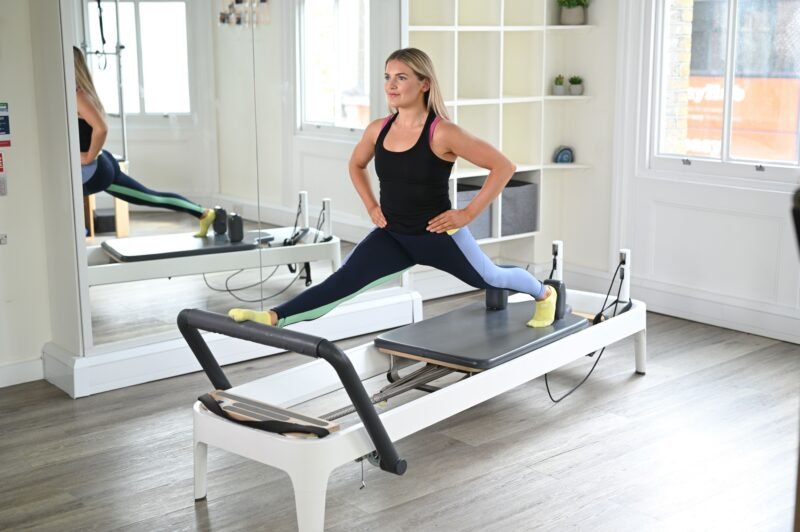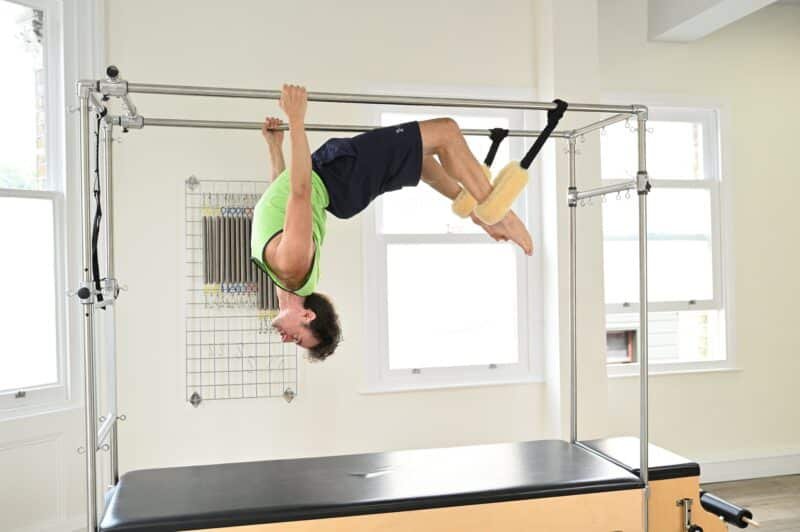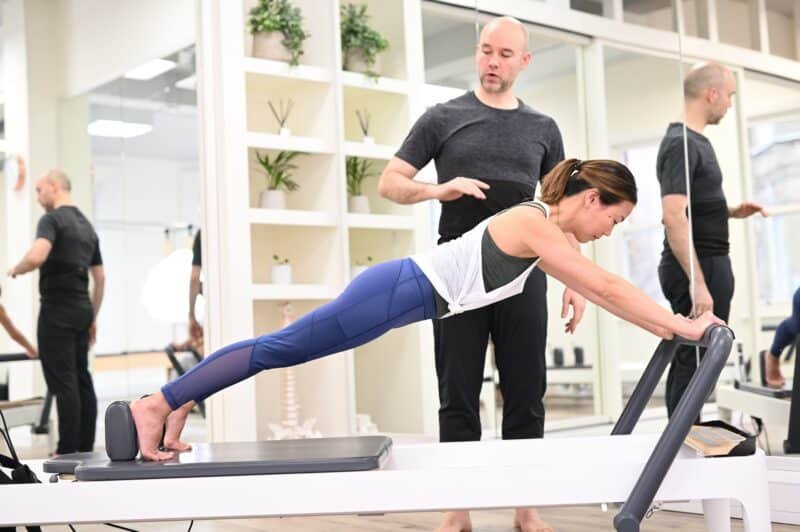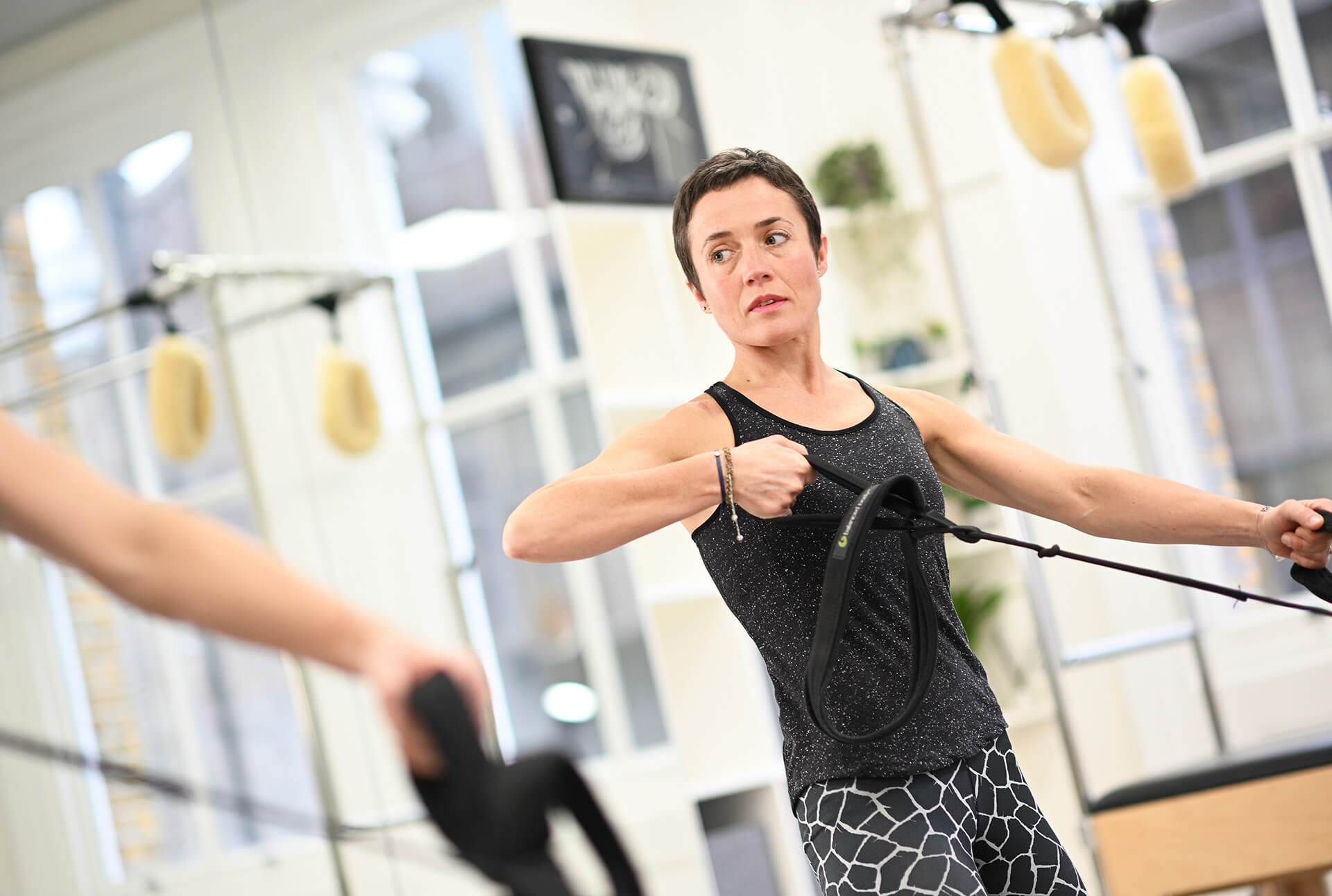Key Contributor: Susie Martin, Chartered Physiotherapist
Are you a keen gymnast? Are you looking for other types of exercise to improve your performance? Are you wondering if Pilates is good for gymnasts? Have you ever considered Pilates?
What is Pilates?
Pilates is a system of exercises for strengthening the whole body that has been around since the 1920’s. It grew in popularity in the 80’s and 90’s until it became the well-known exercise it is today. That popularity is, in part, due to the improvements that Pilates enthusiasts notice in their bodies after practicing for some time.
The benefits of Pilates for gymnasts
Flexibility
It goes almost without saying that gymnasts need incredible flexibility in their shoulders and hips to be able to perform the incredible feats that they do.

Particularly with equipment Pilates, there are many exercises in the Pilates repertoire that help participants stretch into the end range of their movement. This is very valuable for gymnasts.
Spinal mobility
We don’t only need flexibility in the arms and legs to perform movement well, we also need mobility in the spine. Many popular ‘stretches’ fail to address spinal mobility. Both yoga and Pilates are particularly helpful for keeping the spine mobile.

This is particularly important for gymnasts, because working on upper spine mobility can reduce additional stresses on the lower back which is a common place for injury in gymnastics.
Strength
Gymnastics requires lots of strength and power as well as control. Pilates is brilliant for breaking down the different elements of strength for arms, legs, and body, and working on them separately. However, it also has many exercises in the repertoire that can help you to build back up to more full body and integrated movements.

Injury prevention
Pilates encourages full body strength and mobility which helps to distribute forces evenly throughout the body. In addition, there is a focus on body awareness and good movement patterns which reduces the likelihood of developing injuries due to inefficient or faulty movement patterns.
By working on the above factors, gymnasts can reduce the likelihood of injuries and prolong their athletic life.
Injury recovery
Pilates is not only a fantastic injury rehabilitation tool, but it enables you to continue to exercise whilst you recover from an injury.
Gymnastics is very demanding on the body, and so injuries are common. If you are unable to exercise due to injury, you can quickly lose your hard-earned conditioning.
Pilates is a low impact and low intensity form of strength training. The Pilates exercises are designed so that you can move one body part without stressing the adjacent body part so you can still exercise whilst injured. They also comprise a system of progressive levels, so that you can gradually build up from gentle exercises to challenging ones.
In addition, Pilates exercises target strength and mobility in parts of the body and positions that gymnasts need to work in, so you can continue to work on strength and mobility in a way that will have you ready for training when you return to your activity.
Top Pilates Exercises for Gymnasts
Hundreds
The Hundreds is the classic Pilates exercise for working on abdominal endurance with breath control. Dropping the legs lower will make the exercise harder and it resembles the ‘Hollow Hold’ gym exercise.
Rolling like a ball
Rolling like a ball is a great exercise for practice for your tuck position.
Roll Up
The roll up requires abdominal strength, but also requires using breath control to soften the abdominals enough that the spine can articulate up and down.
The Teaser is another classic Pilates exercise which follows on nicely from the roll up. In this variation we use the magic circle
Leg Pull
Leg pull is a great exercise for strengthening the back of the legs and working on your weightbearing strength.
Single leg kick and Double leg kick
Single and double leg kick help you to work on hamstring strength in a challenging position, whilst also working on upper spinal mobility.
Pilates Equipment Exercises for Gymnasts
If you are not familiar with the large Pilates equipment, you can read our blog here to find out all about it. These incredible machines enable you to work out in a whole variety of different ways, from working on your flexibility into greater ranges, to lots of weight bearing through your hands and gripping on to the bars and handles.
Press ups on the Chair

Press ups on the Chair allows you to work on your triceps press with a slight reduction in body weight. This is an important skill for gymnasts, especially those working on the parallel bars.
Russian Splits on the Reformer

The russian splits on the reformer are not just any old splits. The moving platform means that you have to use your strength to be able to control the movement of the carriage. This lengthening under tension is shown to be a more effective way to work on muscle flexibility than just stretching and has the added benefit of helping you protect yourself from injuries. There is an added challenge of having to pull the carriage back in, whilst balancing on a tiny area on the footbar.
Tendon Stretch and Gymnast

The curiously named tendon stretch has much more to do with abdominal control and strength through the arms. This exercise requires shoulder and triceps strength to hold the position on the bar, the feet are wedged on the reformer carriage as the exerciser pressed the carriage away and then requires abdominal strength to control the carriage back up, maintaining the tucked position similar to a pike in gymnastics.
Hanging Up on the Trapeze Table

Hanging up on the Trapeze Table is a great way of developing grip endurance. There are a few exercise variations – from the biceps pull, to the full back extension, shown here. This back extension is a great way to learn how to distribute the extension movement throughout the body which may help prevent back injuries.
Grasshopper on the Ladder Barrel

Similar to the hanging up exercise, grasshopper also works on the back extension position, but this time working against gravity as resistance.
Long stretch on the Reformer

Long stretch on the Reformer is a great variation on a plank position – there are lots of great variations to add here, from a plank to pike, to an arabesque, balanced on one leg. Great for building up weightbearing strength and body strength, especially if you are returning to sport after an injury.
Rollover shoulder stand

The rollover shoulder stand is great way of working on high level abdominal control as you rollover the barrel and bring your legs over your head, to finally arrive in a shoulder stand, working on your body awareness and proprioception in upper body weightbearing.
FAQs
As a gymnast, how often should I do Pilates?
This will depend on your level of training! Elite gymnasts might be training up to 18 hours a week 5 or 6 days per week, so a full Pilates session might only be appropriate as an ‘active recovery’ activity on a rest day. For all athletes, success depends on the ability to balance training with rest and recovery. However, if you are working at a more recreational level you may have time for 2 or 3 Pilates sessions per week. The great thing about Pilates is that it has lots of variety – you could be doing a 10-minute gentle mobility session or a full body strength session for 1 hour so you can adapt it to your needs.
Is Pilates the same as yoga?
No! Pilates and yoga are not the same thing, however, they do have aspects in common. A focus on mind body connection, breathing and fluidity of movement are common to both. Yoga originated in India and is several thousand years old, whereas Pilates was developed by Joseph Pilates at the beginning of the 20th century. Some of the exercises in the Pilates repertoire took inspiration from yoga, so there are definitely overlapping exercises!
Are there any exercises I should avoid?
If you are fit and healthy, with no medical conditions and are not pregnant, then most exercises should be safe for you to do. However, some of the more challenging exercises in the Pilates equipment repertoire should not be attempted without assistance from a qualified professional. For those with medical conditions or injuries, you should always consult a qualified health care professional, such as a doctor or physiotherapist for advice about what is safe for you to do.
Conclusion
Pilates has many benefits to offer the aspiring gymnast, from its focus on strength and control, to flexibility to injury prevention and recovery. In particular, the Pilates large equipment provides many opportunities to take your Pilates to the next practice. If you are not a gymnast, but are feeling inspired, with exercises like hanging up and russian splits – you can feel like a gymnast too!
Feeling inspired?
If you want to experience the Complete difference and discover the benefits of one-to-one Pilates, book a session at one of our London studios or online today.
Our physiotherapist-led Pilates studios in Chelsea, our Angel Pilates studio and our Pilates studio in City, offer a highly tailored approach to your Pilates training, whether your goal is to manage a health condition, rehabilitate from an injury or to improve your strength and fitness.
Get in touch with us via email or contact us on 0203 764 5668 for further information.
Education is key:
These blogs are designed to give information to everyone, however, it is important to remember that everyone is different! If you have not seen one of our therapists and have any questions about injuries, what you have read or whether this may be useful to you, please just ask. We are more than happy to help anyone and point you in the right direction. Our biggest belief is that education is key. The more you understand about your injury, illness and movement, the more you are likely to improve.





